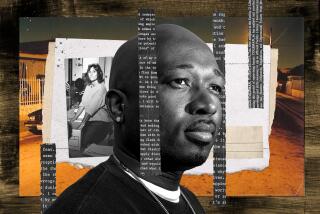Long-ago murder comes vividly to life
- Share via
THEY appeared to be an ideal American family: William Chapman was a widely admired 19th century scientist who claimed he’d found a cure for stammering; his wife, Lucretia, was a well-educated, refined woman who ran a girls’ boarding school in Pennsylvania’s Bucks County. The couple had five children. They were members of a local church and socialized with Philadelphia’s high-society crowd. No one would have expected scandal to touch them. And no one who knew them would have suspected Lucretia in the sudden death of her husband.
Author Linda Wolfe unravels the reality behind this privileged family’s impeccable facade in “The Murder of Dr. Chapman: The Legendary Trials of Lucretia Chapman and Her Lover.” Although their story is rife with disappointment, fraud and betrayal, Wolfe avoids treating it with sensationalism, opting for matter-of-fact detail over hyperbole. Rather than invent dialogue -- a weak device sometimes used by biographers and true-crime authors -- Wolfe relies on letters, court records and newspaper articles of the time.
When the Chapmans married in August 1818, they seemed a happy couple with similar aspirations for work and family life, Wolfe says. But as the years went on, Lucretia found her husband remote and “trying.” He had become hard of hearing and spent entire days alone in his study, often refusing to join the family for dinner.
Eventually, “whether because she felt overworked or because she felt dissatisfied with her life’s lot in general, she ceased being the acquiescent, grateful wife,” Wolfe writes. Lucretia began to tease William about being overweight, insisted that he do some of the household chores and publicly expressed her irritation with him -- even mocking his work to others. (Chapman called himself a doctor, despite having failed to complete his training.) When a 22-year-old Mexican thief and con man named Carolino Entrealgo came to stay with the Chapmans in 1831, things changed irrevocably between them. William Chapman was murdered in June of that year.
Lino Espos y Mina, as Entrealgo called himself, was born into a poor family but pretended he was descended from Spanish royalty. Of the three central figures in the book, he is the most colorful. Though he’d had little in the way of formal education, Lino “had a certain brilliance,” Wolfe writes. “He could converse on all manner of subjects, even with his elders, and entertain his friends with stories of his own devising about pirates and princesses, shipwrecks and hurricanes, vivid accounts he filled with grisly details. He was musical, too, could play the guitar and sing mournful love songs.”
Wolfe recounts Lino’s misadventures in petty theft, his grander schemes and his arrival on the Chapmans’ doorstep, seeking food and lodging. He convinced the Chapmans (especially the gullible Lucretia) that he was the son of a Mexican general and the governor of Upper California, someone who could pay them handsomely for their hospitality. (The money never arrived, of course.) When Ellen, their housekeeper, said she didn’t approve of taking him in, Lucretia retorted, “I’m going to treat him like one of my own sons.” Whenever suspicions about Lino did arise, they were quickly dispelled; he was a charmer who had an explanation for everything, and who deftly erased any remnants of his impoverished, seedy past. Inevitably, Lucretia’s feelings for him shifted from maternal to sexual. Lino loved conversation (unlike her husband) and shared her passion for music. He was young and attractive. William began to seem little more than a nuisance.
Wolfe writes that after Lino’s arrival, Lucretia’s behavior toward William changed drastically. “She flew off the handle at the least provocation. One morning she asked William to help [daughter] Mary turn over a mattress, and when he ignored her, she told him ... she wouldn’t serve him any breakfast.”
In June 1831, barely a month after Lino’s arrival, William suffered an agonizing death from arsenic poisoning. His doctor at first attributed it to cholera. Lino’s gift for lying had served him well. Impeccably dressed, he paid a visit to a local drugstore, convincing the pharmacist to sell him arsenic powder, an essential ingredient for taxidermy. He said that he was planning to stuff and mount some birds.
The villainous Lino is mesmerizing to read about, and he viciously betrays even Lucretia in the end. Throughout the book, Wolfe takes care to put the tragic events of this story into context, studying how issues such as class and privilege affected their trials. Rather than demonize Lucretia as Lino’s smitten fool, Wolfe treats her with sympathy, describing her lonely efforts to rebuild her life after Lino is executed for murdering her husband while she is acquitted.
Wolfe has clearly done her research, but she’s also a fine storyteller, teasing out the details of who did what and how while preserving the suspense. The richness of the material is undeniable -- it has all the elements of a good novel.
*
The Murder of Dr. Chapman
The Legendary Trials of Lucretia Chapman and Her Lover
Linda Wolfe
HarperCollins: 288 pp., $23.95


